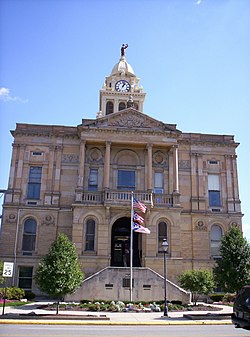Marion County Ohio
| Marion County, Ohio | ||
|---|---|---|

Marion County Courthouse
|
||
|
||
 Location in the U.S. state of Ohio |
||
 Ohio's location in the U.S. |
||
| Founded | May 1, 1824 | |
| Named for | Francis Marion | |
| Seat | Marion | |
| Largest city | Marion | |
| Area | ||
| • Total | 404 sq mi (1,046 km2) | |
| • Land | 404 sq mi (1,046 km2) | |
| • Water | 0.4 sq mi (1 km2), 0.1% | |
| Population | ||
| • (2010) | 66,501 | |
| • Density | 165/sq mi (64/km²) | |
| Congressional districts | 4th, 12th | |
| Time zone | Eastern: UTC-5/-4 | |
| Website | www |
|
Marion County is a county located in the U.S. state of Ohio. As of the 2010 census, the population was 66,501. Its county seat is Marion. The county was created in 1820 and later organized in 1824. It is named for General Francis "The Swamp Fox" Marion, a South Carolinian officer in the Revolutionary War.
Marion County comprises the Marion, OH Micropolitan Statistical Area, which is also included in the Columbus-Marion-Zanesville, OH Combined Statistical Area.
According to the U.S. Census Bureau, the county has a total area of 404 square miles (1,050 km2), of which 404 square miles (1,050 km2) is land and 0.4 square miles (1.0 km2) (0.1%) is water. It is the fifth-smallest county in Ohio by total area.
As of the census of 2000, there were 66,217 people, 24,578 households, and 17,253 families residing in the county. The population density was 164 people per square mile (63/km²). There were 26,298 housing units at an average density of 65 per square mile (25/km²). The racial makeup of the county was 92.10% White, 5.75% Black or African American, 0.19% Native American, 0.52% Asian, 0.01% Pacific Islander, 0.49% from other races, and 0.95% from two or more races. 1.09% of the population were Hispanic or Latino of any race.
...
Wikipedia

